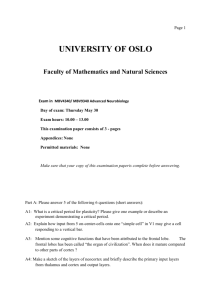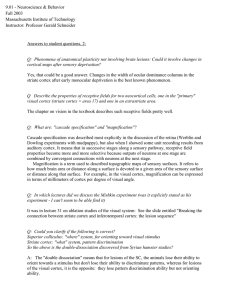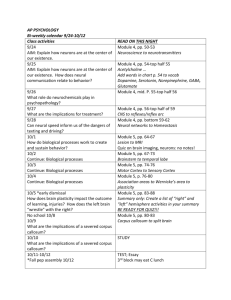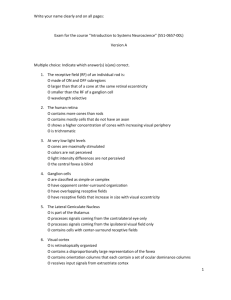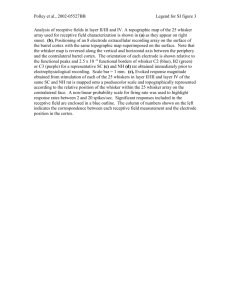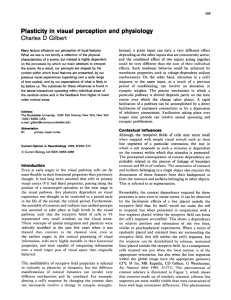CHAPTER 6: THE VISUAL SYSTEM Cortical Vision
advertisement
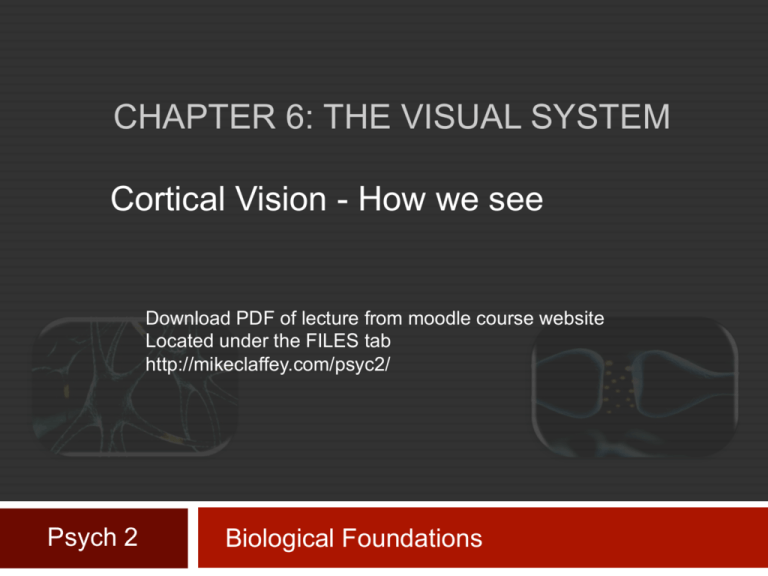
CHAPTER 6: THE VISUAL SYSTEM Cortical Vision - How we see Download PDF of lecture from moodle course website Located under the FILES tab http://mikeclaffey.com/psyc2/ Psych 2 Biological Foundations The flow of information processing in the visual system Receptive Fields Rods Bipolar cells Horizontal / Amacrine cells Retinal Ganglion cells ! LGN C C C C C B B B B B A RG Spike Rate | | | | | Baseline ______________________ Spike Rate | | | | | Baseline ______________________ Center ______________________ ||| ||| ||| | |||| |||| || |||||||| Spike Rate | | | | | Baseline ______________________ Center ______________________ ||| ||| ||| | |||| |||| || |||||||| | | | Surround ______________________ Spike Rate | | | | | Baseline ______________________ Center ______________________ ||| ||| ||| | |||| |||| || |||||||| | | | Surround ______________________ on:off 80:20 ______________________ || ||| ||| | || | || || || ||| || Spike Rate | | | | | Baseline ______________________ Center ______________________ ||| ||| ||| | |||| |||| || |||||||| | | | Surround ______________________ on:off 80:20 ______________________ || ||| ||| | || | || || || ||| || on:off 60:40 ______________________ | | | | | | | | || | | | | | Receptive fields in the cortex Receptive fields in the cortex A B Clicker Question " Why would the white area within the receptive field of “A” be perceived as less bright than “B” a) more on-center rods are being activated in “A” # b) more off-surround rods are being activated in “A” # c) there is less total light hitting “A” # Clicker Question " Why would the white area within the receptive field of “A” be perceived as less bright than “B” a) more on-center rods are being activated in “A” # b) more off-surround rods are being activated in “A” # c) there is less total light hitting “A” # on:off 60:40 ______________________ | | | | | | | | || | | | | | on:off 80:20 ______________________ || ||| ||| | || | || || || ||| || Receptive fields in the cortex " In the primary visual cortex, neurons with circular receptive fields are rare # unlike LGN or striate layer IV neurons Receptive fields in the cortex " Most neurons in V1 are either Simple - small rectangular on/off receptive fields # Complex - large rectangular, respond to stimuli anywhere in receptive field # Simple Cells Have straight-line on/off regions " Unresponsive to diffuse light " Monocular " Complex Cells " No on/off regions # A line with the appropriate orientation anywhere in the receptive field will activate cell Responsive to motion in a particular direction " Involved with depth perception " Binocular " Columnar Organization of PVC " Neurons that respond similarly are grouped in vertical columns Plasticity in the Visual Cortex Plasticity in the Visual Cortex " Hebbian plasticity Neurons that fire together, wire together # Neurons that don’t fire together lose potentiation # Experimental Design " " Experimental Model Primary visual cortex cats " Recording and Stimulation ephys single unit electrodes # " iontophoresis # # " recorded action potentials K+ stimulation Cl- inhibition visual stimuli paired with # # stimulation inhibition Experiment 1 Orientation preference change Step 1 - Find the neuron # # Find neuron that responds selectively to vertical but not horizontal stim Stimuli: solid line swept across a visual field at 1.5o per second Peristiumulus Time Histograms - action potentials per second per 1.5o 5 a.p.s-1 " 1.5o / sec Experiment 1 Orientation preference change Step 2 - Train the neuron # # horizontal line + iontophoretic activation vertical line + iontophoretic inhibition +3 nA 5-1a.p.s-1 5 a.p.s " 1.5o / sec 1.5o / sec -7 nA Plasticity in the Visual Cortex " Hebbian plasticity Neurons that fire together, wire together # Neurons that don’t fire together lose potentiation # Experiment 1 Orientation preference change " Step 3 - Measure the effect # trained activation/inhibition response lasted at least 110 min 1.5o / sec Damage to the Visual System Damage to Primary Visual Cortex " Scotomas Areas of blindness in contralateral visual field due to damage to primary visual cortex # Detected by perimetry test # " Completion # Patients may be unaware of scotoma – missing details supplied by “completion” Damage to primary visual cortex cont. " Blindsight Response to visual stimuli outside conscious awareness # Reaching to grab a moving object located in scotoma # # Possible explanations of blindsight $ Direct connections between subcortical structures and secondary visual cortex, not available to conscious awareness Cortical Mechanisms of Vision Cortical Mechanisms of Vision Dorsal and Ventral Streams " Dorsal stream: # # # " dorsal prestriate cortex to posterior parietal cortex The 䇾where䇿 pathway (location and movement), or Pathway for control of behavior (e.g. reaching) Ventral stream: # # # ventral prestriate cortex to inferotemporal cortex The 䇾what䇿 pathway (color and shape), or Pathway for conscious perception Dorsal and Ventral Streams Ventral Stream Damage - Prosopagnosia " " Inability to distinguish among faces Prosopagnosia is associated with damage to the ventral stream between the occipital and temporal lobes # " Fusiform face area Indicates a specialized function for “What” processing Conclusion " Questions?

